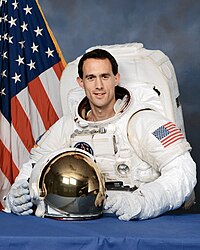James H. Newman
| James H. Newman | |
|---|---|
 | |
| Land | USA |
| Organisation | NASA |
| ausgewählt | 17. Januar 1990 (13. NASA-Gruppe) |
| Einsätze | 4 Raumflüge |
| Start des ersten Raumflugs | 12. September 1993 |
| Landung des letzten Raumflugs | 12. März 2002 |
| Zeit im Weltraum | 43d 10h 07min |
| EVA-Einsätze | 6 |
| EVA-Gesamtdauer | 43h 13min |
| ausgeschieden | Juli 2008 |
| Raumflüge | |
James H. Newman (James Hansen Newman; * 16. Oktober 1956 auf Truk im Treuhandgebiet Pazifische Inseln, heute Chuuk in den Föderierten Staaten von Mikronesien) ist ein ehemaliger US-amerikanischer Astronaut.
Beginn der Karriere
Newman machte seinen Schulabschluss auf der La Jolla High School in San Diego in Kalifornien, daraufhin studierte er Physik am Dartmouth College und schloss mit dem Bachelor cum laude 1978 ab. Seinen Master und Doktor machte er an der Rice University 1982 respektive 1984. Nach seinem Abschluss arbeitete er weiter an der Rice University und ab 1985 nebenbei im Johnson Space Center der NASA.
NASA
1990 wurde er in die 13. Astronautengruppe der NASA gewählt. Sein Spezialgebiet sind die tragbaren Computer für die Arbeit im Weltraum und die Vor- und Nachbereitungen der Crew eines Raumfluges.
STS-51
Seinen ersten Raumflug absolvierte er mit der Discovery vom 12. – 22. September 1993. Seine Aufgabe bestand darin, dass er den Shuttle Pallet Satellite bearbeitete und bei Außenbordaktivitäten neue Hilfsmittel und Techniken für folgende Missionen testete. Die Landung erfolgte im Kennedy Space Center in Florida.
STS-69
Mit der Endeavour ging es vom 7. – 18. September ins All, um Montagetechniken für die ISS zu testen. Währenddessen wurden noch Experimente durchgeführt, die die Intensität des Sonnenwindes gemessen haben und die extremen ultravioletten Emissionen des Plasma-Toros des Jupiters zu messen, die von seinem Mond Io ausgehen. Die Landung erfolgte wieder in Florida.
STS-88
Abermals flog er mit der Endeavour vom 4. – 16. Dezember 1998 in All, diesmal jedoch war er an der Einweihungsmission der ISS beteiligt, denn die Raumfähre hatte das erste Verbindungsmodul Unity der Raumstation nebst zweier Kopplungsadapter (PMA-1 und PMA-2) im Laderaum. Hier war Newman als Missionsexperte gefragt, denn er hatte auf den vorhergehenden Flügen die Montagetechniken in der Schwerelosigkeit erprobt. Auch bei dieser Mission erfolgte die Landung in Florida.
STS-109
Seinen vierten Flug machte er vom 1. – 12. März 2002 mit der Columbia zum Hubble-Weltraumteleskop. Bei dieser Mision wurden Wartungsarbeiten durchgeführt, unter anderem wurde das Steuerungssystem und die Solarpanelen ausgetauscht. Wiederum wurde in Florida gelandet.
Zusammenfassung
| Nr. | Mission | Funktion | Flugdatum | Flugdauer | |
|---|---|---|---|---|---|
| Start | Landung | ||||
| 1 | STS-51 | Missionsspezialist | 12. September 1993 | 22. September 1993 | 9d 20h 11m |
| 2 | STS-69 | Missionsspezialist | 7. September 1995 | 18. September 1995 | 10d 20h 28m |
| 3 | STS-88 | Missionsspezialist | 4. Dezember 1998 | 16. Dezember 1998 | 11d 19h 17m |
| 4 | STS-109 | Missionsspezialist | 1. März 2002 | 12. März 2002 | 10d 22h 09m |
Nach den Raumflügen
Von Dezember 2002 bis Januar 2006 arbeitete Newman im ISS Program Office und war dort für die NASA-Tätigkeiten in Russland zuständig.
Ab März 2006 lehrte Newman als NASA-Austauschprofessor an der Naval Postgraduate School (NPS) in Monterey. Im Juli 2008 verließ er die NASA und nahm eine Professur an der NPS an.
Privat
Er ist mit seiner Frau Mary verheiratet und hat drei Kinder. Seine Hobbys sind Wandern, Fußball, Baseball, Squash und Gliding.
Ferner ist er Mitglied der Studentenverbindung Sigma Chi.
Siehe auch
- Liste der Weltraumausstiege
- Liste der Raumfahrer
- Liste der Space-Shuttle-Missionen
- Liste der bemannten Raumflüge
Weblinks
- NASA-Biografie von James H. Newman (englisch; PDF)
- Biografie von James H. Newman in der Encyclopedia Astronautica (englisch)
- Kurzbiografie von James H. Newman bei spacefacts.de
| Personendaten | |
|---|---|
| NAME | Newman, James H. |
| ALTERNATIVNAMEN | Newman, James Hansen |
| KURZBESCHREIBUNG | US-amerikanischer Astronaut |
| GEBURTSDATUM | 16. Oktober 1956 |
| GEBURTSORT | Mikronesien |
Auf dieser Seite verwendete Medien
Emblem of Nasa's STS-69 mission.
- Designed by the mission crew members, the patch for STS-69 symbolizes the multifaceted nature of the flight's mission. The primary payload, the Wake Shield Facility (WSF), is represented in the center by the astronaut emblem against a flat disk. The astronaut emblem also signifies the importance of human beings in space exploration, reflected by the planned space walk to practice for International Space Station (ISS) activities and to evaluate space suit design modifications. The two stylized Space Shuttles highlight the ascent and entry phases of the mission. Along with the two spiral plumes, the stylized Space Shuttles symbolize a NASA first, the deployment and recovery on the same mission of two spacecraft (both the Wake Shield Facility and the Spartan). The constellations Canis Major and Canis Minor represent the astronomy objectives of the Spartan and International Extreme Ultraviolet Hitchhiker (IEH) payload. The two constellations also symbolize the talents and dedication of the support personnel who make Space Shuttle missions possible.
Designed by the crew members, this patch commemorates the first assembly flight to carry United States-built hardware for constructing the International Space Station (ISS). This flight's primary task is to assemble the cornerstone of the Space Station: the Node with the Functional Cargo Block (fgb).
The rising sun symbolizes the dawning of a new era of international cooperation in space and the beginning of a new program: the International Space Station. The Earth scene outlines the countries of the Station Partners: the United States, Russia, those of the European Space Agency (ESA), Japan, and Canada. Along with the Pressurized Mating Adapters (PMA) and the Functional Cargo Block, the Node is shown in the final mated configuration while berthed to the Space Shuttle during the STS-88/2A mission.
Emblem of Nasa's STS-109 mission.
Emblem of Nasa's STS-51 mission.
Astronaut James H. Newman




